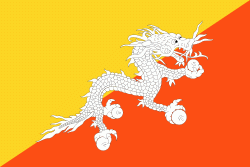Mongar District (Mongar)
Mongar District (Dzongkha: མོང་སྒར་རྫོང་ཁག་; Wylie: Mong-sgar rdzong-khag) is one of the 20 dzongkhags (districts) comprising Bhutan. Mongar is the fastest-developing dzongkhag in eastern Bhutan. A regional hospital has been constructed and the region is bustling with many economic activities. Mongar is noted for its lemon grass, a plant that can be used to produce an essential oil. It also has a hydroelectric power-plant on the Kuri Chhu river. Mongar is notable for having the longest work time in all the dzongkhags of Bhutan.
Mongar is home to a variety of Bhutanese languages and dialects. In the east, the East Bodish Tshangla (Sharchopkha) is the dominant language, also used as a regional lingua franca.
Central Mongar is the only region where the East Bodish Chali language is spoken, by about at total of 8,200 people in Wangmakhar, Gorsum and Tormazhong villages, mainly in and around Chhali Gewog on the east bank of the Kuri Chhu River.
Southern Mongar is likewise unique for its 1,000 Gongduk speakers living in a few inaccessible villages of Gongdue Gewog near the Kuri Chhu river. The language appears to be the sole representative of a unique branch of the Tibeto-Burman language family and retains the complex verbal agreement system of Proto-Tibeto-Burman.
In southwestern Mongar, residents speak Khengkha, an East Bodish language closely related to Bumthangkha languages including Kurtöp. Bumthangkha itself is also spoken by the natives of extreme northwest Mongar. Residents of the Kuri Chhu valley of northern Mongar speak Chochangachakha language, a Central Bodish language very closely related to Dzongkha, the national language.
Mongar is home to a variety of Bhutanese languages and dialects. In the east, the East Bodish Tshangla (Sharchopkha) is the dominant language, also used as a regional lingua franca.
Central Mongar is the only region where the East Bodish Chali language is spoken, by about at total of 8,200 people in Wangmakhar, Gorsum and Tormazhong villages, mainly in and around Chhali Gewog on the east bank of the Kuri Chhu River.
Southern Mongar is likewise unique for its 1,000 Gongduk speakers living in a few inaccessible villages of Gongdue Gewog near the Kuri Chhu river. The language appears to be the sole representative of a unique branch of the Tibeto-Burman language family and retains the complex verbal agreement system of Proto-Tibeto-Burman.
In southwestern Mongar, residents speak Khengkha, an East Bodish language closely related to Bumthangkha languages including Kurtöp. Bumthangkha itself is also spoken by the natives of extreme northwest Mongar. Residents of the Kuri Chhu valley of northern Mongar speak Chochangachakha language, a Central Bodish language very closely related to Dzongkha, the national language.
Map - Mongar District (Mongar)
Map
Country - Bhutan
 |
 |
| Flag of Bhutan | |
The subalpine Himalayan mountains in the north rise from the country's lush subtropical plains in the south. In the Bhutanese Himalayas, there are peaks higher than 7000 m above sea level. Gangkhar Puensum is Bhutan's highest peak and is the highest unclimbed mountain in the world. The wildlife of Bhutan is notable for its diversity, including the Himalayan takin and golden langur. The capital and largest city is Thimphu, holding close to 1/7th of the population.
Currency / Language
| ISO | Currency | Symbol | Significant figures |
|---|---|---|---|
| BTN | Bhutanese ngultrum | Nu | 2 |
| INR | Indian rupee | ₹ | 2 |
| ISO | Language |
|---|---|
| DZ | Dzongkha language |















